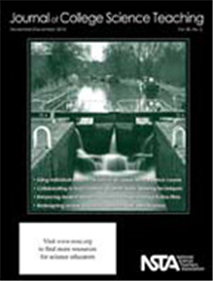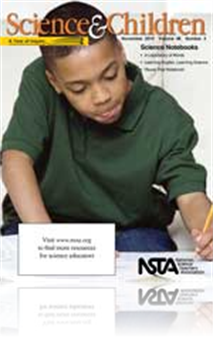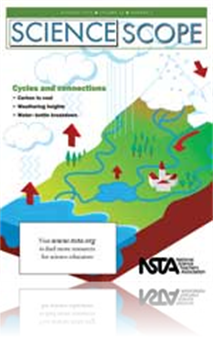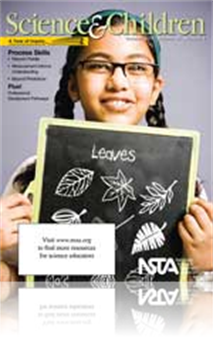All Resources
Journal Article
It seems that every year, the author sees more examples in television, movies, and even books of dislike, distrust, and disdain of the field of science. In “real” life, she teaches increasing numbers of students outspoken in their assertions that...
Journal Article
Being flat, Mercator maps inherently misrepresent some aspects of Earth’s geography. That’s because there is absolutely no way to simultaneously conserve all of the elements of three-dimensional space in a two-dimensional model. To dispel misconc...
Journal Article
Graphically Enhanced Science Notebooks
A common mode of communication in the elementary classroom is the science notebook. In this article, the authors outline the ways in which “graphically enhanced science notebooks” can help engage students in complete and robust inquiry. Central t...
Journal Article
Students are using the tools of scientists when keeping a science notebook. They are also keeping track of their thinking and the changes to their original ideas. To bring students’ existing ideas out for examination, the author implemented a “qu...
Journal Article
Guest Editorial: Making Meaning With Notebooks
Communication is vital to science and has a central role in inquiry—students of all ages need to have a place and a means to reflect on their ideas. Language becomes the primary avenue that students use to arrive at and communicate their scientific...
Journal Article
This summer, the environmental disaster in the Gulf of Mexico unfolded with more drama than a summer blockbuster. America was riveted by a deadly explosion, a seemingly unstoppable geyser of toxic petroleum, beach cleaners in hazmat suits, and the me...
Journal Article
Editor’s Note: A Foolproof Tool
It’s difficult to think of a tool we use in science classes that provides as much for student learning as a science notebook. It supports the development of science skills, processes, and understanding as well as literacy, numeracy, and attitudes. ...
Journal Article
Guest Editorial: A revolutionary model of professional development
Traditionally, professional development in education has focused on three main areas: content, general pedagogy, or pedagogical content knowledge. While each area has its own purpose, in this article the author focuses on what the literature states s...
Journal Article
Editor’s Corner: Inquiring Minds
Regular readers of The Science Teacher (TST) may have noticed a lot of articles on scientific inquiry and notable among TST articles on inquiry are Bell and colleagues' “Simplifying Inquiry Instruction” and McComas’s “Laboratory Instruction i...
Journal Article
Astronomical Scale of Stellar Distances Using 3-D Models
One of the largest challenges of teaching astronomy is bringing the infinite scale of the universe into the four walls of a classroom. However, concepts of astronomy are often the most interesting to students. This article focuses on an alternative m...
Journal Article
Using Google Earth to Study the Basic Characteristics of Volcanoes
With the advent of Google Earth and the database of volcanoes supplied by the Smithsonian Institution’s Global Volcanism Program, students can describe almost any volcano on Earth. In this article, the authors guide students to use tools in Google ...
Journal Article
Nonfiction Literacy in Kindergarten
After an outdoor excursion hunting for a “special leaf” on a delightful fall day, students returned to the classroom and were instructed to capture the leaf on a blank page in their science notebooks. They were asked to document as many details a...
Journal Article
Using “hands-on” instruction in the science classroom has obvious value for both teachers and students. However, just because a type of instruction does not allow students to physically interact with objects does not mean it is not worthwhile. On...
Journal Article
Case Study: Cooking Under Pressure—Applying the Ideal Gas Law in the Kitchen
This case study uses a daily cooking scenario to demonstrate how the boiling point of water is directly related to the external pressures in order to reinforce the concepts of boiling and boiling point, apply ideal gas law, and relate chemical reacti...
Journal Article
Everyday Engineering: Toothbrush design—Is there a better bristle?
Manufacturers often claim that their particular toothbrush design is better than the competitors, but is it? As a result, engineers must consider the economic issues involved with selling the products they create, as well as their functionality: to p...
Journal Article
Clickers Beyond the First-Year Science Classroom
This case study’s primary objective is to describe the implementation of the electronic response system (clickers) in a small (N = 25) second-year physics course at a large public university and to draw attention of the science faculty who teach up...
Journal Article
Science 101: How do oil and gas companies know where to drill?
Contrary to popular opinion, most oil is not discovered by a backwoods hunter shooting at some food when up through the ground comes bubbling crude (you younger people ask your parents what silly TV program the author is referring to). Neither is it ...
Journal Article
In the lesson presented in this article, students learn to organize their thinking and design their own inquiry experiments through careful observation of an object, situation, or event. They then conduct these experiments and report their findings i...
Journal Article
Research and Teaching: Data-Driven Implementation and Adaptation of New Teaching Methodologies
This paper describes an action research approach toward an implementation of a new teaching methodology (specifically active learning) in a preparatory college chemistry classroom. The initial implementation involved the use of process-orientated gui...
Journal Article
One way to advance inquiry in the classroom is to establish a systematic strategy for reflecting on our practice and our students’ readiness to engage in increasingly complex scientific reasoning. The Matrix for Assessing and Planning Scientific In...
Journal Article
The departments of Geology and Education at Brooklyn College collaborated with five informal educational institutions in the development of a place-based graduate program for Earth science teachers. The team used “backward design” to develop a pr...
Journal Article
Exploring Osmosis and Diffusion in Cells
Guided inquiry is an instructional technique that requires students to answer a teacher-proposed research question, design an investigation, collect and analyze data, and then develop a conclusion (Bell, Smetana, and Binns 2005; NRC 2000). In this ar...
NSTA Press Book
Predict, Observe, Explain: Activities Enhancing Scientific Understanding
John Haysom and Michael Bowen provide middle and high school science teachers with more than 100 student activities to help the students develop their understanding of scientific concepts. The powerful Predict, Observe, Explain (POE) strategy, field-...
By John Haysom, Michael Bowen
NSTA Press Book
Hop Into Action: The Amphibian Curriculum Guide for Grades K–4
K–4 teachers, homeschoolers, camp leaders, and naturalists will find the standards-based lessons in this slim volume the perfect introduction to environmental science for young learners. Hop Into Action helps teach children about the joy of amphibi...
By David Alexander
Journal Article
Science Sampler: Solar Panels and alternative energy in the eighth-grade classroom
In this solar panels and alternative energy project, students were challenged to develop a researchable question about solar energy and electronics and devise a means of answering it. Students worked cooperatively, with specific roles for each member...
Journal Article
Guest Editorial: Inquiry, Process Skills, and Thinking in Science
Inquiry is central to science education today. But understanding its many nuances is still an issue according to research (Flick and Lederman 2004). And understanding is the first step to implementations. In this article, the author identifies six qu...
Journal Article
Measurement Informs Understanding
It is common practice for elementary classes to plant seeds so that students have the opportunity to observe them germinate and grow. Beyond introducing plant anatomy, this relatively simple activity has the potential to engage children as young plan...
Journal Article
Science Pipes: A World of Data at Your Fingertips
A new online tool called Science Pipes allows students to conduct biodiversity investigations. With this free tool, students create and run analyses that would otherwise require access to unwieldy data sets and the ability to write computer code. Usi...
Journal Article
Teacher’s Toolkit: Strategies for the meaningful evaluation of multiple-choice assessments
Too many multiple-choice tests are administered without an evaluative component. Teachers often return student assessments or Scantron cards—computerized bubble forms—without review, assuming that the printing of the correct answer will suffice. ...
Journal Article
The “Magic” String is a discrepant event that includes a canister with what appears to be the end of two strings protruding from opposite sides of it. Due to the way the strings are attached inside the canister, it appears as if the strings can m...
Journal Article
Editor’s Note: Inquiry—Process Skills
We take for granted that students have some abilities in questioning, observing, predicting, planning an investigation, collecting data, interpreting information, and communicating their ideas. But, this is more than likely not the case. We must be d...
Journal Article
Transporting Students Into Thin Air: Using Science to Enhance Reading
The Into Thin Air unit, based on the book by Jon Krakauer, was designed as an interdisciplinary unit for a small group of academically gifted sixth-grade students. It included hands-on, minds-on activities that would immerse students in the scientifi...
Journal Article
Connect the Spheres with the Coal Cycle
Coal fueled the Industrial Revolution and, as a result, changed the course of human history. However, the geologic history of coal is much, much longer than that which is recorded by humans. In your classroom, the coal cycle can be used to trace the ...
Journal Article
Teaching Through Trade Books: Kitchen Chemistry
The kitchen is a wondrous place for children to make observations and explore the basics of chemistry. Seize the opportunity and help students build process skills while cooking or baking. Almost everything we eat and certainly everything that is com...
Journal Article
Tried and True: Physics fun with toy cars
According to the National Science Education Standards, students should be able to describe an object by its position, direction of motion, and speed (NRC 1996). During a unit on motion, the author decided to use Hot Wheels cars as the object students...









